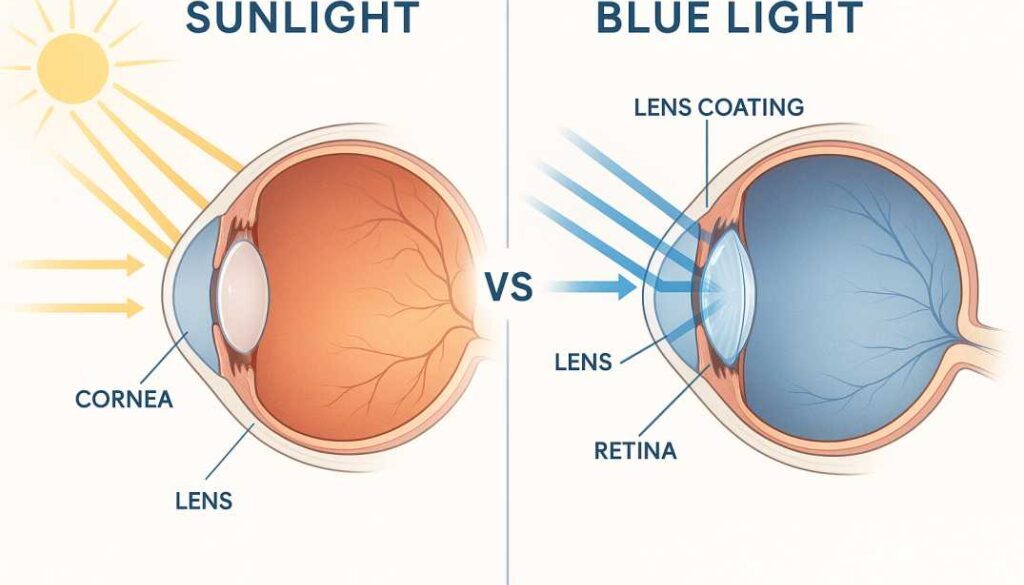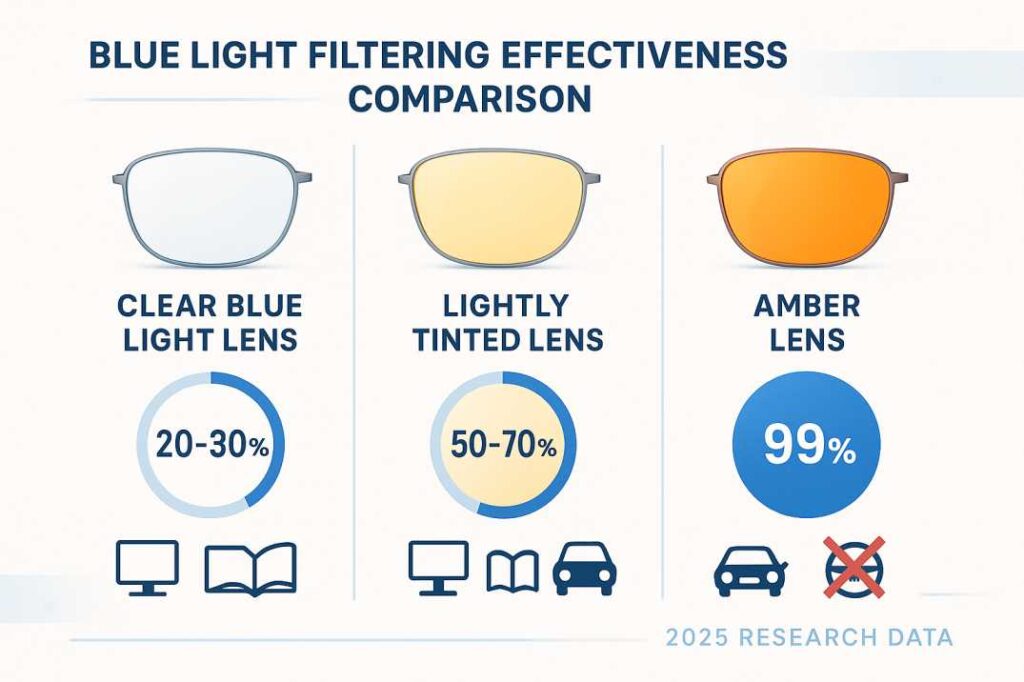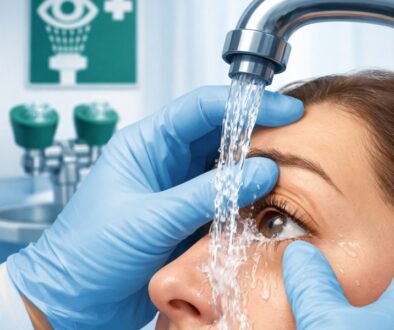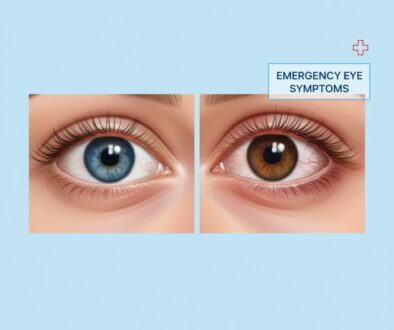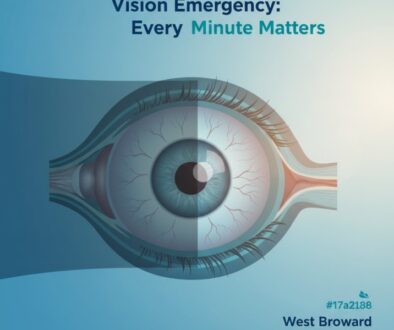Blue Light Protection: What the Evidence Shows
Executive Summary
Blue light lenses, while heavily marketed for digital eye strain relief, show limited scientific evidence for their primary claims. Recent comprehensive studies, including a gold-standard Cochrane systematic review, reveal that these specialized lenses provide minimal benefits for reducing eye fatigue or improving sleep quality. However, evidence-based alternatives—including proper screen ergonomics, the 20-20-20 rule, and comprehensive eye care—offer proven protection for families navigating our digital age.
Key Findings:
- Clear blue light lenses filter only 20-30% of blue light exposure
- No significant reduction in digital eye strain symptoms versus regular lenses
- Traditional eye care practices remain more effective than specialized eyewear
- Cost-effectiveness favors proven prevention strategies over lens upgrades
Understanding Blue Light Lenses: Technology and Mechanisms
Blue light lenses represent a category of specialized eyewear designed to reduce exposure to high-energy visible (HEV) light wavelengths between 380-500 nanometers. These lenses employ two primary technologies: absorption-based filtering materials embedded within the lens matrix, and surface reflection coatings that redirect blue light away from the eye.
Technical Specifications and Filtering Effectiveness
Contemporary blue light protection systems demonstrate varying efficacy levels:
Clear Lens Technology:
- Filtration range: 20-30% of the blue light spectrum
- Optimal for all-day wear with minimal color distortion
- Primary targeting: 415-455nm wavelengths (peak digital device emission)
Enhanced Tinted Systems:
- Filtration range: 50-70% of the blue light spectrum
- Slight amber tinting may affect color perception
- Recommended for dedicated computer work environments
Maximum Protection Lenses:
- Filtration range: Up to 99% of the blue light spectrum
- Significant color distortion limits practical applications
- Specialized use for light-sensitive individuals
Biological Context: Blue Light Exposure in Modern Life
To understand blue light lenses’ potential impact, we must examine human blue light exposure patterns. Natural sunlight remains our primary blue light source, delivering approximately 1000 times more blue light than digital screens. Even prolonged digital device use typically exposes users to less than 1% of established safety thresholds for blue light exposure.
Digital Eye Strain: Understanding the Real Culprits
Contemporary research reveals that digital eye strain symptoms result from behavioral and environmental factors rather than blue light exposure specifically.
Primary Contributing Factors
Reduced Blink Quality and Frequency: Recent studies demonstrate that incomplete blinking, rather than reduced blink frequency, primarily drives dry eye symptoms during screen use. While blink rates during computer use (14.9 blinks/minute) don’t differ significantly from reading printed materials (13.6 blinks/minute), the quality of blinks decreases substantially during digital tasks.
Accommodation and Convergence Stress: Extended near-vision tasks require sustained accommodation (focusing) and convergence (eye alignment) efforts. This muscular strain contributes significantly to eye fatigue symptoms, particularly when screen positioning or prescription accuracy is suboptimal.
Environmental and Ergonomic Factors: Poor lighting conditions, improper screen positioning, and inadequate workplace ergonomics create additional visual stress independent of blue light exposure. These modifiable factors often provide the greatest opportunity for symptom relief.
Evidence-Based Symptom Management
The 20-20-20 Protocol: Every 20 minutes, focus on an object at least 20 feet away for a minimum of 20 seconds. This evidence-based practice relieves accommodation stress and encourages complete blinking patterns.
Environmental Optimization:
- Position screens 20-26 inches from the eyes
- Ensure the screen top aligns with or sits below eye level
- Minimize contrast between screen brightness and the surrounding environment
- Utilize task lighting to reduce glare and shadowing
Conscious Blinking Practices: Encourage complete, deliberate blinks throughout digital tasks. Incomplete blinks fail to distribute tear film effectively across the corneal surface, contributing to dryness and irritation.
Blue Light Protection: When Lenses May Provide Value
Despite limited evidence for primary marketed benefits, blue light lenses may offer advantages in specific circumstances.
Circadian Rhythm Considerations
- Evening Blue Light Exposure: Research demonstrates that blue light exposure within 2-3 hours of bedtime can suppress melatonin production and delay sleep onset. For individuals who must use digital devices during evening hours, blue light filtering may provide modest circadian benefits.
- Shift Workers and Irregular Schedules: Healthcare professionals, first responders, and other shift workers may benefit from strategic blue light management as part of comprehensive circadian rhythm optimization.
Subjective Comfort and Individual Sensitivity
- Light Sensitivity Populations: Individuals with conditions such as migraine, traumatic brain injury, or certain neurological conditions may experience subjective comfort improvements with blue light filtering, though specialized therapeutic lenses often provide superior relief.
- Placebo and Confidence Effects: Some users report improved comfort that may result from placebo effects or increased awareness of digital eye strain symptoms. While not scientifically measurable, these subjective benefits may justify lens costs for some individuals.
Pediatric Considerations: Protecting Developing Eyes
Children’s visual systems present unique considerations regarding blue light exposure and digital device use.
Developmental Eye Health Factors
- Increased Blue Light Transmission: Children’s crystalline lenses transmit more blue light to the retina compared to adult eyes, theoretically increasing exposure to photoreceptor cells. However, no current evidence suggests this increased transmission causes measurable harm at typical exposure levels.
- Myopia Development Concerns: Emerging research suggests excessive near work and reduced outdoor activity—rather than blue light exposure—drive increasing childhood myopia rates. Blue light lenses do not address these primary risk factors.
Evidence-Based Pediatric Eye Protection
Screen Time Management:
- Limit recreational screen time per American Academy of Pediatrics guidelines
- Encourage regular outdoor activities (minimum 90 minutes daily)
- Ensure proper lighting during screen use
- Model healthy digital habits as family practices
Regular Comprehensive Eye Examinations: Annual eye examinations detect refractive errors, binocular vision problems, and other conditions that contribute to digital eye strain symptoms more effectively than specialized lenses.
Alternative Protection Strategies: Evidence-Based Approaches
Technology-Based Solutions
- Device-Integrated Blue Light Filters: Most modern devices include built-in blue light reduction settings (“Night Mode,” “Blue Light Filter”) that adjust color temperature automatically. These software solutions often provide superior filtering compared to clear lens coatings while maintaining color accuracy for tasks requiring precise color discrimination.
- Environmental Lighting Controls: LED lighting with adjustable color temperature allows optimization of ambient lighting conditions throughout the day, supporting natural circadian rhythms more effectively than eyewear-based filtering.
Lifestyle and Behavioral Modifications
Optimized Screen Ergonomics: Proper workstation setup addresses multiple factors contributing to digital eye strain simultaneously:
- Monitor positioning for neutral neck posture
- Adequate task lighting to minimize contrast
- Regular posture breaks to reduce muscular tension
- Hydration and humidification for tear film stability
Digital Wellness Practices:
- Establish device-free periods, particularly before bedtime
- Implement gradual screen brightness reduction in evening hours
- Practice mindful blinking during concentrated visual tasks
- Maintain regular sleep schedules to support natural circadian rhythms
Economic Considerations: Cost-Effectiveness Analysis
Blue Light Lens Investment Analysis
Direct Costs (2025 Market Data):
- Budget retailers: $19-50 blue light coating upgrades
- Premium providers: $95-200+ for complete blue light lens systems
- Replacement considerations: 1-2 year typical lens lifecycle
Opportunity Cost Evaluation: Resources invested in blue light lenses could alternatively fund:
- Comprehensive eye examinations addressing underlying vision problems
- Ergonomic workplace improvements with broader health benefits
- Professional consultation for persistent eye strain symptoms
Alternative Investment Benefits
Proven Prevention Strategies:
- Workplace ergonomic assessments: $100-300, addressing multiple health factors
- Quality task lighting: $50-150, improving visual comfort and productivity
- Professional eye examinations: $150-300, detecting and correcting underlying vision problems
Clinical Decision-Making Framework
Patient Assessment Considerations
For eye care professionals evaluating blue light lens recommendations:
Primary Assessment Factors:
- Existing refractive error correction adequacy
- Binocular vision function evaluation
- Tear film quality and quantity assessment
- Workplace ergonomic evaluation
- Sleep hygiene and circadian rhythm patterns
Evidence-Based Treatment Hierarchy:
- Correct underlying refractive errors and binocular vision problems
- Optimize workplace ergonomics and environmental factors
- Implement proven digital eye strain prevention protocols
- Address systemic factors affecting tear film stability
- Consider blue light filtering for specific populations with documented benefits
Informed Consent Considerations
Patients considering blue light lenses should understand:
- Limited scientific evidence supporting primary marketed benefits
- Alternative evidence-based approaches with superior efficacy
- Individual variation in symptom response and treatment effectiveness
- Economic considerations and opportunity costs
Future Research Directions and Emerging Evidence
Ongoing Research Priorities
- Long-term Exposure Studies: Current research focuses on the acute effects of blue light filtering. Long-term longitudinal studies examining cumulative effects over years or decades remain limited, though early evidence suggests minimal concern at typical exposure levels.
- Individual Variation Research: Emerging research explores genetic and physiological factors that may predict individual responses to blue light exposure and filtering effectiveness. This personalized medicine approach may identify specific populations who benefit from targeted interventions.
- Technology Development: Advanced lens materials with selective wavelength filtering and adaptive technologies represent active research areas. Future innovations may provide more targeted blue light management while maintaining optimal visual performance.
Clinical Practice Evolution
- Evidence-Based Protocol Development: Professional organizations continue refining clinical guidelines based on emerging research. Future protocols may incorporate blue light assessment and management within comprehensive digital wellness evaluations.
- Integration with Digital Health Monitoring: Wearable technology and smartphone applications increasingly monitor light exposure patterns, potentially enabling personalized blue light management recommendations based on individual usage patterns and circadian preferences.
Key Resources and Scientific Citations
1. Cochrane Systematic Review: Blue-Light Filtering Spectacle Lenses
Source: Cochrane Database of Systematic Reviews (2023)
Link: https://pubmed.ncbi.nlm.nih.gov/37593770/
Key Finding: Comprehensive analysis of 17 randomized controlled trials found no significant short-term advantages of blue-light filtering lenses for reducing visual fatigue or improving sleep quality.
2. American Academy of Ophthalmology: Digital Device Eye Safety
Source: American Academy of Ophthalmology Position Statement (2024)
Link: https://www.aao.org/eye-health/tips-prevention/are-computer-glasses-worth-it
Key Finding: Official position that there is no scientific evidence supporting special eyewear for computer use, with recommendations for alternative evidence-based approaches.
3. Clinical Research: Blink Patterns and Digital Eye Strain Mechanisms
Source: Optometry and Vision Science Journal (2024)
Link: https://pubmed.ncbi.nlm.nih.gov/24413278/
Key Finding: Incomplete blinking quality, rather than frequency alone, drives digital eye strain symptoms, with no significant difference in blink rates between screen and print reading.
Conclusion: Evidence-Based Recommendations for Families
Based on a comprehensive analysis of current scientific evidence, blue light lenses offer limited proven benefits for their primary marketed applications. While generally safe and potentially helpful for specific individuals, they do not represent the most effective or cost-efficient approach to digital eye strain management for most families.
Primary Recommendations
For Immediate Implementation:
- Establish consistent 20-20-20 break protocols during digital tasks
- Optimize workspace ergonomics and lighting conditions
- Practice conscious, complete blinking during concentrated visual work
- Implement evening device usage limitations 2-3 hours before bedtime
For Professional Evaluation:
- Schedule comprehensive eye examinations to address underlying vision problems
- Consult with eye care professionals regarding persistent symptoms
- Consider workplace ergonomic assessments for individuals with chronic eye strain
- Evaluate sleep hygiene and circadian rhythm optimization strategies
For Blue Light Lens Consideration:
- Individuals with documented light sensitivity conditions
- Shift workers requiring evening digital device use
- Patients who have optimized other factors without symptom resolution
- Personal preference after understanding evidence limitations
The West Broward Eyecare Associates Commitment
As your trusted vision guardians serving Tamarac, Woodmont, and the surrounding West Broward communities, we remain committed to evidence-based practice and transparent patient education. Our recommendations prioritize proven strategies that protect your family’s vision health while respecting your healthcare investment decisions.
Ready to protect your family’s vision with comprehensive, evidence-based care? Contact West Broward Eyecare Associates to schedule your consultation. Our experienced optometrists provide personalized eye care solutions that go beyond marketing trends to deliver measurable results for your family’s visual health.
About West Broward Eyecare Associates: Serving the Tamarac, Woodmont, and West Broward communities with comprehensive, evidence-based eye care. Our board-certified optometrists combine advanced diagnostic technology with personalized patient care to protect and preserve vision for families throughout South Florida.
FAQs
-
Scientific evidence remains mixed, though many users report reduced eye strain and headaches. Blue light glasses filter 10-25% of blue light, which may help some individuals who spend extended periods on digital screens.

